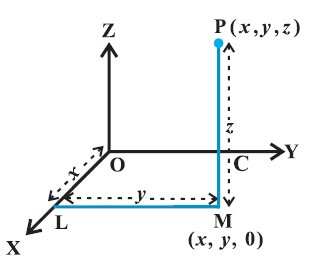
Let us study about Coordinate Axes and Coordinate Planes in Three Dimensional Space.
Consider three planes intersecting at a point O such that these three planes are mutually perpendicular to each other (Fig). These
three planes intersect along the lines X′OX, Y′OY
and Z′OZ, called the x, y and z-axes, respectively.
We may note that these lines are mutually
perpendicular to each other.
These lines constitute the rectangular coordinate system. The planes XOY, YOZ and ZOX, called, respectively the XY-plane, YZ-plane and the ZX-plane, are known as the three coordinate planes. We take the XOY plane as the plane of the paper and the line Z′OZ as perpendicular to the plane XOY. If the plane of the paper is considered
as horizontal, then the line Z′OZ will be vertical. The distances measured from
XY-plane upwards in the direction of OZ are taken as positive and those measured
downwards in the direction of OZ′ are taken as negative. Similarly, the distance
measured to the right of ZX-plane along OY are taken as positive, to the left of
ZX-plane and along OY′ as negative, in front of the YZ-plane along OX as positive
and to the back of it along OX′ as negative. The point O is called the origin of the
coordinate system. The three coordinate planes divide the space into eight parts known
as octants. These octants could be named as XOYZ, X′OYZ, X′OY′Z, XOY′Z,
XOYZ′, X′OYZ′, X′OY′Z′ and XOY′Z′. and denoted by I, II, III, ..., VIII , respectively.
Hope the above explanation helped you, now let me explain you about Navigational Coordinates.
 The smallest multiple common to both 2 and 3 is 6.
The smallest multiple common to both 2 and 3 is 6. The least common multiple of 2, 3, and 4 is 12.
The least common multiple of 2, 3, and 4 is 12. The smallest multiple common to both 2 and 3 is 6.
The smallest multiple common to both 2 and 3 is 6. The least common multiple of 2, 3, and 4 is 12.
The least common multiple of 2, 3, and 4 is 12.


 Let us learn about Coordinates of a Point in Space,
Let us learn about Coordinates of a Point in Space,